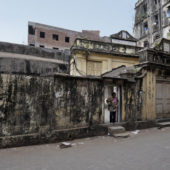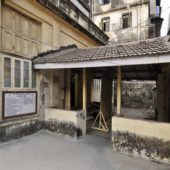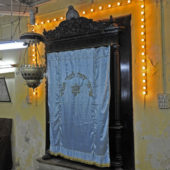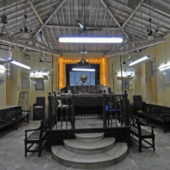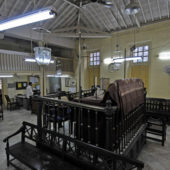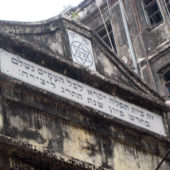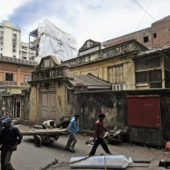The Shaare Rason, known as the New Synagogue, is situated hardly a furlong away from the older Shaar Harahamim (Gate of Mercy) Synagogue. It was built by a splinter group within the Jewish community
Shaare Rason Synagogue was established by a group of Bene Israel Jews who broke away from the existing congregations. Bene Israel is perhaps the only sect of Judaism who have not been subjected to anti-Semitism. Having lived harmoniously with their Indian neighbors for over 2,000 years, they have been free to worship and practice Judaism, and to live as a community. They have been fully included into Indian society, yet have still retained their “separateness.”
The Bene Israeli claim to be direct descendents from the lost “ten tribes” of Israel. Biblical history relates that these ten tribes formed the Kingdom of Israel, which were exiled from their capital, Samaria, by the Assyrian King, Shalmaneser and subsequent kings from 722 BCE onwards. Other Bene Israeli believe that their ancestors escaped from Israel by sea in 175 BCE during the reign of Antiochus Epiphanes (prior to the events leading to Hannukah). Legend recounts that on the sea voyage from Israel, the forefathers of the Bene Israeli were shipwrecked and washed ashore the Konkan coast, south of Bombay. There were only fourteen survivors, seven women and seven men. They buried their dead near the village of Nawgaon, which later became the foundation of the first Bene Israel cemetery. The surviving Bene Israeli were offered to settle permanently in the Konkan villages. They adopted Hindu names similar to their first names, but added “-kar” onto their surnames, often indicating where they came from, for example: Penkar came from the village of Pen.
Many Bene Israeli at that time worked as oil pressers. To outsiders, the Bene Israeli did not appear different to others Indians, with the exception that they observed the Sabbath, celebrated major festivals, circumcised their sons and performed most of the prescribed Biblical offerings. Most of the prayers were forgotten, except for the “Shema Israel…” (Heal, O Israel…”). When David Rahabi arrived, the Bene Israel came into contact with the other Jews. It is unclear as to whether he was an 18th century Cochin Jew, or whether the Bene Israel tradition that records his arrival as far back as 1,000 CE is correct. Either way, he was a Cochin Jew who helped promote unity between all Indian Jews. He allegedly inspired them to begin celebrating Shavuot, Sukkoth, as well as, more minor feasts and fasts, which they had not been observing prior to their relationship with him. By the 19th century, Cochin Jews were involved in training the Bene Israel religious leadership: teachers, cantors and ritual slaughterers.
In 1745 the Divekar family, were the first Bene Israel family to settle in Bombay (now known as Mumbai), where religious freedom was ensured by the British. Their five sons were employed by the East India Trading Company. In 1796, additional Bene Israel families followed the Divekar family and moved to Bombay. By the end of the 19th century, the Bene Israel workers in Bombay were performing white-collar work, and employed as doctors, lawyers, writers, architects, professors, teachers, nurses, secretaries, social workers, civil servants and skilled workers in factories and workshops. Bene Israel families began to emigrate from as far as Burma and Aden to Bombay. The Bene Israel population grew from 6,000 in the 1830s to 10,000 by the turn of the century. In 1948 there were 20,000 Bene Israel in India; however, this number decreased to 16,000 as a result of emigration to Israel. Today, there are less than 5,000 Jews in India, most of whom are Bene Israel, due to further numbers emigrating not only to Israel, but also to the United States, Britain, Canada and Australia. At the beginning of the 21st century over 60,000 Bene Israel lived in Israel.
Shaare Rason Synagogue was built in 1840, in the Kodak area of Bombay. The first synagogue in Bombay was Shaar Harahamim (Gate of Mercy), built in 1796 by the Divekar family. Situated hardly a furlong away, Shaare Rason is an Orthodox Synagogue. Its somewhat rustic exterior features Hebrew scriptures and a Star-of-David above the entrance of its time-worn façade. The prayer room is in better condition, although the plaster of its ivory walls is peeling. Paned windows with light wood shutters punctuate the walls, and beautiful stone tiles line the floors. The bimah is in the center of the room, featuring a stone platform with a beautiful dark wood balustrade surrounding it, and the tivah (reader’s desk) inside. The Aron Kodesh is likewise, beautifully carved of dark wood, with a white Torah curtain drawn across it and yellow lights surrounding. The women’s gallery runs along the back of the prayer room, upstairs, with a light wood panel separating the gallery from the main sanctuary. It is supported by two columns, running from the ceiling, through the women’s gallery, down to the ground floor of the prayer room. Attractively carved dark wood pews are situated throughout the prayer room. The prayer room’s high ceilings and exposed truss construction lend a light and spacious atmosphere.

